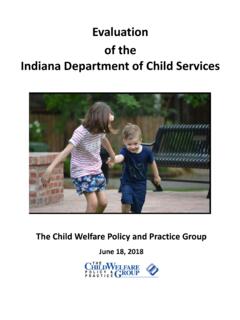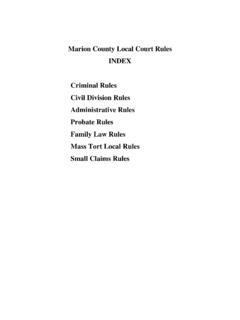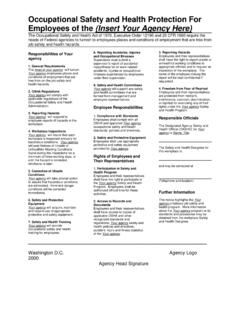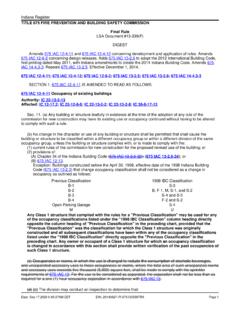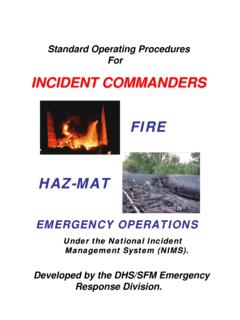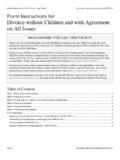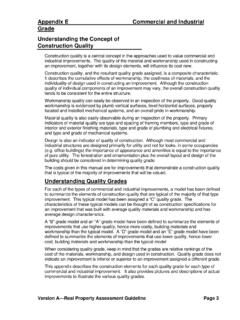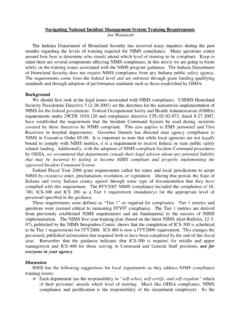Transcription of Indiana State Government COVID-19 Guidance Frequently …
1 Updated January 28, 2022 This document provides Guidance for State of Indiana employees and managers during the COVID-19 pandemic. The information included in this document combines resources from the Indiana Department of Health (IDOH) and the Centers for Disease Control and Prevention (CDC). Additional information and Guidance can be found at each of their websites. This document may be updated Frequently as further Guidance is available and conditions change. Answers provided in this document may differ for 24/7 operations.
2 Contact your manager and HR representative with additional questions. Indiana State Government COVID-19 Guidance & Frequently Asked Questions 2 Indiana State Government COVID-19 Guidance Document & FAQ 1/28/22 Table of Contents Section 1: Workplace Prevention Measures What has changed? What up-to-date means When and how to get vaccinated How well COVID-19 vaccines work Required daily health self-screenings Proper handwashing & hand sanitizing Required social distancing in the workplace Increased workplace cleanliness standards Mask & glove requirements Changes at the Indiana Government Center Government facilities not part of the Indiana Government Center Visitors Section 2.
3 Daily Health Self-Screening Symptoms consistent with known causes Symptoms not consistent with known causes COVID-19 exposure Self-screening duration Section 3: When an Employee Is Displaying COVID-19 Symptoms What should employees do if they have symptoms consistent with a known cause, such as seasonal allergies or asthma? What should employees do who have symptoms consistent with COVID-19 that are not associated with a known cause? Section 4: When an Employee Is Exposed To COVID-19 What should employees do if they have been exposed to someone with a confirmed case of COVID-19 in the last 10 days?
4 Section 5: When an Employee Tests Positive for COVID-19 What should employees who are not up-to-date do if they did not test positive for COVID-19 ? Section 6: Childcare Resources Section 7: Self-Care Resources Practicing mindfulness Mental health services Employee Assistance Program (EAP) & Other Resources 3 Indiana State Government COVID-19 Guidance Document & FAQ 1/28/22 Section 1: Workplace Prevention Measures What has changed? According to the Centers for Disease Control and Prevention (CDC), people who are up-to-date on vaccines can participate in many of the activities they did prior to the pandemic (Stay Up to Date with Your Vaccines | CDC).
5 CDC defines up-to-date as having received all vaccines doses that are recommended, including boosters and additional primary doses for people who are immunocompromised. On Dec 27, 2021, the CDC updated and shortened the recommended isolation and quarantine periods for the general population. Specific application to State of Indiana employees is outlined below in Sections 4 and 5. Up-to-date State employees, including contractors and temporary employees: Are highly encouraged to wear masks inside common/public areas of all State buildings to maximize protection against SARS-CoV-2 and prevent spread.
6 This is especially important to prevent transmission of the omicron variant. o This includes conference rooms and other confined spaces. o When State employees are in another work setting outside of their normal location, masks are recommended in indoor public spaces in areas of substantial or high transmission. Do not need to quarantine after a known exposure to COVID-19 unless they have symptoms. They should wear a well-fitting mask at all times around others, including outdoors, for 10 days. Employees are also strongly encouraged to get a PCR or rapid antigen test 5 days following the exposure.
7 Should monitor for signs and symptoms, including completion of the daily COVID-19 screenings, and isolate and get a PCR or rapid antigen test if symptoms develop. Should avoid travel and avoid being around people who are at high-risk of severe infection. New Notice Requirements: Employees are required to immediately report positive test results to their manager and HR department. Immediate notice is critical in order to ensure that CDC guidelines are followed. Employees are required to perform contact tracing and adequately notify impacted individuals to whom they came in close contact.
8 The CDC now has an online tool, , to assist individuals in the contact tracing process. COVID-19 vaccinations are not required for employees to return to the workplace; however, employees are highly encouraged to be vaccinated. Masks must be worn by all individuals present inside State Government congregate facilities which are the Indiana Department of Correction prisons, the State Hospitals, the Indiana Veterans Home, and the Indiana Law Enforcement Academy. Being up-to-date on COVID-19 vaccination is the best protective measure against COVID-19 and allows you to resume normal workplace and daily activities.
9 What does up-to-date mean? You are up to date with your COVID-19 vaccines when you have followed the current recommendations listed here. More specifically: People ages 12 and older are considered up-to-date when they have received their two-dose primary series of Pfizer or Moderna vaccine followed by a booster dose at least five months after the second dose (if eligible); or when they have received their first dose of Johnson and Johnson 4 Indiana State Government COVID-19 Guidance Document & FAQ 1/28/22 vaccine followed by a booster dose at least two months after the first dose (Pfizer and Moderna are preferred as booster vaccines).
10 Anyone ages 12 and older is highly recommended to get a vaccine booster dose when eligible. Individuals 12-17 years of age should get a Pfizer vaccine booster (only) at least five months after completing their second Pfizer dose. Individuals 18 years of age and older who received a two-dose vaccine series should get any booster dose at least five months after their second dose. Individuals 18 years of age and older who received a Johnson and Johnson primary dose should get any booster at least two months after their primary dose.
